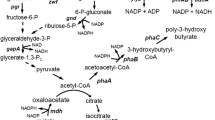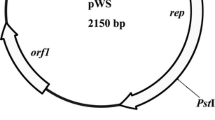Abstract
A recombined E. coli-A. latus shuttle vector plasmid pKTC32 harboring the cloned phbC gene from Alcaligenes latus was constructed, and transformed by electroporation into the parent A. latus in order to amplify the PHB synthase. The rate of PHB biosynthesis and content of PHB increased significantly after the transformation of the cloned phbC gene, plus the plasmid stability remained relatively high at around 85%. The enhanced PHB biosynthesis mechanism produced in the transformant A. latus was investigated by measuring the variations of enzyme activities related to the PHB biosynthesis.
Similar content being viewed by others
References
Anderson AJ, Dawes EA (1990) Occurrence, metabolism, metabolic role, and industrial uses of bacterial polyhydroxyalkanoates.Microbiol. Rev. 54: 246–250.
Braunegg G, Sonnleitner B, Lafferty RM (1978) A rapid gaschromatographic method for the determination of poly-_-hydroxybutyric acid in microbial biomass. Eur. J. Appl. Microbiol. 6: 29–37.
Chen GO, König KH, Lafferty RM (1991) Production of poly-D(_)-3-hydroxybutyrate and poly-D(_)-3-hydroxyvalerate by strainsof Alcaligenes latus. Antonie van Leeuwenhoek 60: 61–66.
Doi Y (1990) Microbial Polyesters. New York: VCH Publishers, Inc.
Fulai W, Lee SY (1997) Poly(3-hydroxybutyrate) production with high productivity and high polymer content by fed-batch cultureof Alcaligenes latus under nitrogen limitation. Appl. Environ. Microbiol. 63: 3703–3706.
Grothe E, Moo-Young M, Chisti Y (1999) Fermentation optimizationfor the production of poly(_-hydroxybutyric acid) microbialthermoplastic. Enzyme Microbiol. Tech. 25: 132–141.
Hanggi UJ (1990) Pilot-scale production of PHB with Alcaligeneslatus. In: Dawes EA, ed. Novel Biodegradable Microbial Polymers.Dordrecht: Kluwer Academic Publishers, pp. 143–159.
Haywood GW, Anderson AJ, Dawes EA (1989) The importance of PHB synthase substrate specificity in polyhydroxyalkanoatesynthesis by Alcaligenes eutrophus. FEMS Microbiol. Lett. 57:1–6.
Hiramitsu M, Koyama N, Doi Y (1993) Production of poly(3-hydroxybutyrate-co-4-hydroxybutyrate) by Alcaligenes latus.Biotechnol. Lett. 15: 461–464.
Hrabak O (1992) Industrial production of poly-_-hydroxybutyrate.FEMS Microbiol. Rev. 103: 251–156.
Jung YM, Lee YH (1997) Investigation of regulatory mechanism offlux of acetyl-CoA in Alcaligenes eutrophus using PHB negative mutant and transformants harboring cloned phb CAB genes. J.Microbiol. Biotech. 7: 215–222.
Jung YM, Park JS, Lee YH (2000) Metabolic engineering of Alcaligeneseutrophus through the transformation of cloned phb CABgenes for the investigation of the regulatory mechanism of polyhydroxyalkanoatebiosynthesis. Enzyme Microbiol. Technol. 26:201–208.
Lee YH, Kim TW, Park JS, Huh TL (1996) Effect of the supplementationof metabolites on cell growth and poly-_-hydroxybutyratebiosynthesis of Alcaligenes latus. J. Microbiol. Biotechnol. 6:120–127.
Lee YH, Park JS, Huh TL (1997) Enhanced biosynthesis of P(3HB-3HV) and P(3HB-4HB) by amplification of the cloned PHBbiosynthesis genes in Alcaligenes eutrophus. Biotechnol. Lett. 19: 771–774.
Maekawa B, Kayama N, Doi Y (1993) Purificaiton and properties of3-ketothiolase from Alcaligenes latus. Biotechnol. Lett. 15: 691–696.
Oeding V, Schlegel HG (1973) _-Ketothiolase from Hydrogenomonaseutropha H16 and its significance in the regulation of poly-_-hydroxybutyrate metabolism. Biochem. J. 134:243–248.
Park HC, Lim KJ, Park JS, Lee YH, Huh TL (1995a) High frequencytranformation of Alcaligenes eutrophus producing poly-_-hydroxybutyric acid by electroporation. Biotechnol. Tech. 9:31–34.
Park HC, Park JS, Lee YH, Huh TL (1995b) Manipulation of thegene for poly-_-hydroxybutyric acid synthesis in Alcaligeneseutrophus. Biotechnol. Lett. 17: 729–734.
Park JS, Huh TL, Lee YH (1995c) Production of poly-_-hydroxybutyrate by Alcaligenes eutrophus transformant harbouringcloned phb CAB genes. Biotechnol. Lett. 17: 735–740.
Park JS, Huh TL, Lee YH (1997) Characteristics of cell growth andpoly-_-hydroxybutyrate biosynthesis of Alcaligenes eutrophus transformants harboring cloned phb CAB genes. J. Microbiol.Biotech. 21: 85–90.
Wang F, Lee SY (1997) Production with high productivity and highpolymer content by a fed-batch culture of Alcaligenes latus under nitrogen limitation. Appl. Environ. Microbiol. 63: 3703–3706.
Yamane T, Fukunage M, Lee YW (1996) Increased PHB productivity by high-cell-density fed-batch culture of Alcaligeneslatus, a growth-associated PHB producer. Biotechnol. Bioeng. 50: 197–202.
Author information
Authors and Affiliations
Rights and permissions
About this article
Cite this article
Lee, YH., Seo, IS., Jung, YM. et al. Construction of transformant Alcaligenes latus enforcing its own cloned phbC gene and characterization of poly-β-hydroxybutyrate biosynthesis. Biotechnology Letters 22, 961–967 (2000). https://doi.org/10.1023/A:1005628908532
Issue Date:
DOI: https://doi.org/10.1023/A:1005628908532




